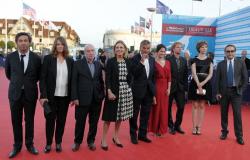Through the publication of Baya or the grand opening, Alice Kaplan returns in great detail to the grand opening of the Baya exhibition which took place on November 21, 1947 at the Maeght gallery in Paris, when she was aged 16 years old.
This 234-page work published by Barzakh Editions, quite well dissected, contains valuable information on Baya Mahieddine, one of the icons of Algerian painting. The American writer and historian Alice Kaplan was present last Tuesday at the Ezzou’Art gallery in Algiers to talk about her recent work. With her skillful pen, Alice Kaplan brings readers back to life the first opening of the painter Baya, on November 21, 1947, at the Maeght gallery in Paris. The destiny of the young teenager is turned upside down for the better. This opening will open the doors to recognition and meetings for him. It presents 149 watercolors and 10 figurines that will not leave anyone indifferent. On the official invitation card, the artist is presented as “14 year old Kabyle girl”.
Among the distinguished guests who came to attend this very first exhibition of colored painting, was Albert Camus, Henri Matisse, Michelle Auriol and George Braque. Thus, Baya will have the chance to meet the greatest intellectuals and artists of the time, including Albert Camus, Pablo Picasso and André Breton. Four years ago, the little motherless child worked as a maid on Henri Farges’ farm. A year later, Baya was invited to the Madour workshops, in Vallauris, in the Alpes-Maritimes, to devote herself to terracotta sculptures. It was then that she met the painter Picasso and even shared a couscous with him. Alice Kaplan recalls that the sister of the farm owner Marguerite Caminat takes care of Baya at her home in Algiers.
A dreamlike universe
She provides the teenager with a teacher who teaches her French. Better yet, she gives him all the materials to paint and sculpt. This is where Baya, the autodidact, devotes himself wholeheartedly to his passion. Through her so-called naive painting, she gives birth to a dreamlike universe made up of birds, gardens and flowers in shimmering colors.
The poet Jean Sénac was friends with Baya. One of his publications is illustrated with drawings in Baya’s ink. Alice Kaplan notes that there is also a very worrying coincidence between Jean Sénac and Marguerite Caminat: they occupied the same building on rue Elisée Reclus, near the Sacré Cœur in Algiers. For information, Marguerite Caminat with little Baya subsequently moved to 5 rue d’Isly in Algiers. In the artistic world of the time, some attributed a resemblance between the Mexican artist Kahlo Frida and Baya. Alice Kaplan does not share this opinion. They are completely different, even in painting. According to her, “when it comes to personality and aura, the two women are different. At 31, Kahlo embodies flamboyant egotism. At 15 years old, Baya rather evokes elegance and discretion. However, they were presented in a comparable way, as two artists from the southern hemisphere interpreting their culture of origin for delighted Americans or Europeans. Like Baya, Kahlo appears in public in exuberant traditional costumes, echoed in the vibrant reds and yellows of her painting. Like Baya after her, Kahlo was honored by Vogue magazine.
The American writer warns that she is not an art historian, she is rather a historian, studying reception. And what we can learn by digging through Marguerite Caminat’s papers. Asked if Alice Kaplan came across one of Baya’s works by chance, she admits, when she was five or six years old, there was a painting she loved in the gallery in her town. It was a painting entitled The Big Blue Horses created by the German expressionist painter Frantz Marc. “There is an incredible blue,” she says, “and when I looked at Baya’s paintings, I remembered my childhood, which I was able to keep there without a second thought, without the weight of my entire academic career. Baya brought me freshness. She gave me a real gift, that is to say, a vision that I had somewhat lost. I will always be grateful to him. A stroke of madness for a painter or even for a writer cannot be explained. That’s part of the charm.”
The American historian speaks of Baya with great passion.
“I think she’s carrying me. I also have the honor of making her known. It is also a privilege to make her known and to have been able to access her papers. Alice Kaplan delivers a book Baya ou le grand vernissage which focuses on the restitution of a period in Baya’s life. She discovered in the overseas archives, in Aix, a ton of information about the exhibition at the Maeght gallery in Paris. From the archives of Marguerite Caminat, composed of press clippings, letters, a diary, a list of paintings sold in 1947 with prices. “I tried,” explains the speaker, “to follow a few paintings to see if I could identify the provenance of a few paintings. In my opinion, it is the history of Baya which was in some way mistreated by colonialism. I didn’t go after independence. I sketch but I don’t talk about it. Her children told me that it was more about Baya’s private life. I had less information on this. This is what we call in history a micro history or a targeted biography.
Unexploited archives
Our speaker admits that she decided to write about the painter Baya when she knew that there was an untapped archive. “It’s something I know how to do. So I said to myself, I know how to go find an archive and tell a story around all these thousands of documents. I think that Marguerite Caminat, who donated the archive, would have wanted to write a book on Baya, but she was unable to do so. In these archives, she underlined comments in red. His sentences were like magic signs for me. She was challenging me. I had this impression that I was in communication with her. It’s difficult to collect dozens and dozens of documents. I worked on this book for three years,” she adds.
It should be noted that Baya or the grand opening was the subject of a first publication by the French editions Le bruit du monde, a second by the private Algerian editions Barzakh, a third release of the book in the United States in October 2024 .






